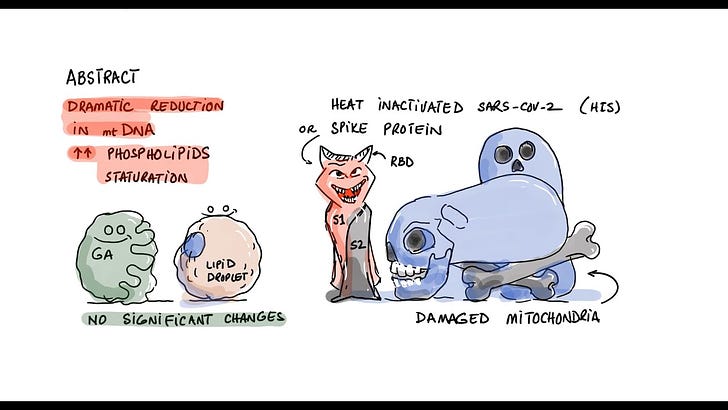How spike protein causes mitochondria damage
New revelations into the unhappy genotoxic family of complex chronic illnesses
An important discussion by Dr Been and some new studies have just come to light showing how spike protein is able to damage mitochondrial DNA and thus disrupt cell processes and health, which will ultimately have systemic effects on overall health and wellbeing.
Each cell in your body is its own little factory (they are little protein factories) and like a little factory it has many more detailed moving parts called organelles which are like different departments that work within the factory. Organelles work together and perform their own unique tasks to make, package and distribute proteins. The mitochondria are the powerplants or engines of the cell. They produces energy for the cell in the form of ATP. This drives the rest of the cells ability to function. If you have a factory with a power cut, production ceases or slows down and it is unable to keep up with operational demands.
Each cell forms a collective of cells we commonly refer to as tissues, eg Muscle tissue, Lung tissue, Kidney tissue and so on. These tissues all act or work together to build organs and organ systems, Muscles, the Lungs, Kidneys, our Heart and our Skeleton etcetera. And those organ systems all work together to create you. A living breathing able to read this sentence, person.
So if mitochondria are damaged within a cell and that cell isn’t able to function and produce proteins like it is supposed to, the tissues work poorly, the organ systems work poorly and so too do you work poorly.
Now all the different types of cells in our bodies, from all different tissues types are all different to one another. Some cells have lots of mitochondria (like nerve and muscle cells) and others have less. But they are all different.
Thus it is reasonable to assume…
Not all mitochondria will be affected equally, some tissues will have greater exposure to spike protein than other tissues depending on bio-distribution.
Not all mitochondria in a single cell will become injured, but in some cases only a few might, in others many will become damaged and the cell will die as a result.
If cells are not damaged enough, eg the power output in the factory is reduced but not stopped cold, the factory will continue to work just more slowly and less efficiently. It will also produce a lot more waste in the form of oxidative stress.
If cells are surviving in a damaged or crippled state, they may still be able to duplicate and divide, passing the genetic damages on to the daughter cells.
These cells continue to divide and eventually replace healthy cells in tissues over an unspecified length of time.
That the period of time required for the onset of any observable symptoms is going to be highly varied, depending on a host of factors, like which tissues were exposed, how many cells in those tissues, how many mitochondria in those cells and so on and so on.
This means observable symptoms can vary a lot depending on which organ systems are damaged or misfunctioning. Eg damage to neurons, immune cells, parts of the endocrine system or cardiac tissues will result in different symptoms in clinical presentations.
This might also explain immune dysfunction, skin conditions, hair loss, nerve disorders, tinnitus, diabetes and a host of other inflammatory conditions too.
But if we can find a way to treat the mitochondria, repair them, or help our bodies identify the poorly performing cells, isolate and remove them, we could likely treat and or reverse a whole host of chronic complex conditions!
See more about some of these other conditions here in an older post of mine.
The references I cite in this article are also very interesting, if you have the time please read those too. Churr.





What frightens me beyond prenatal damage to a fetus is the toxic effect of flouroquinalones which have been prescribed for decades. Thank you for your diligence. - Mark Gerald Weissinger AB MDiv BSc BSMed MD FACS FACOG